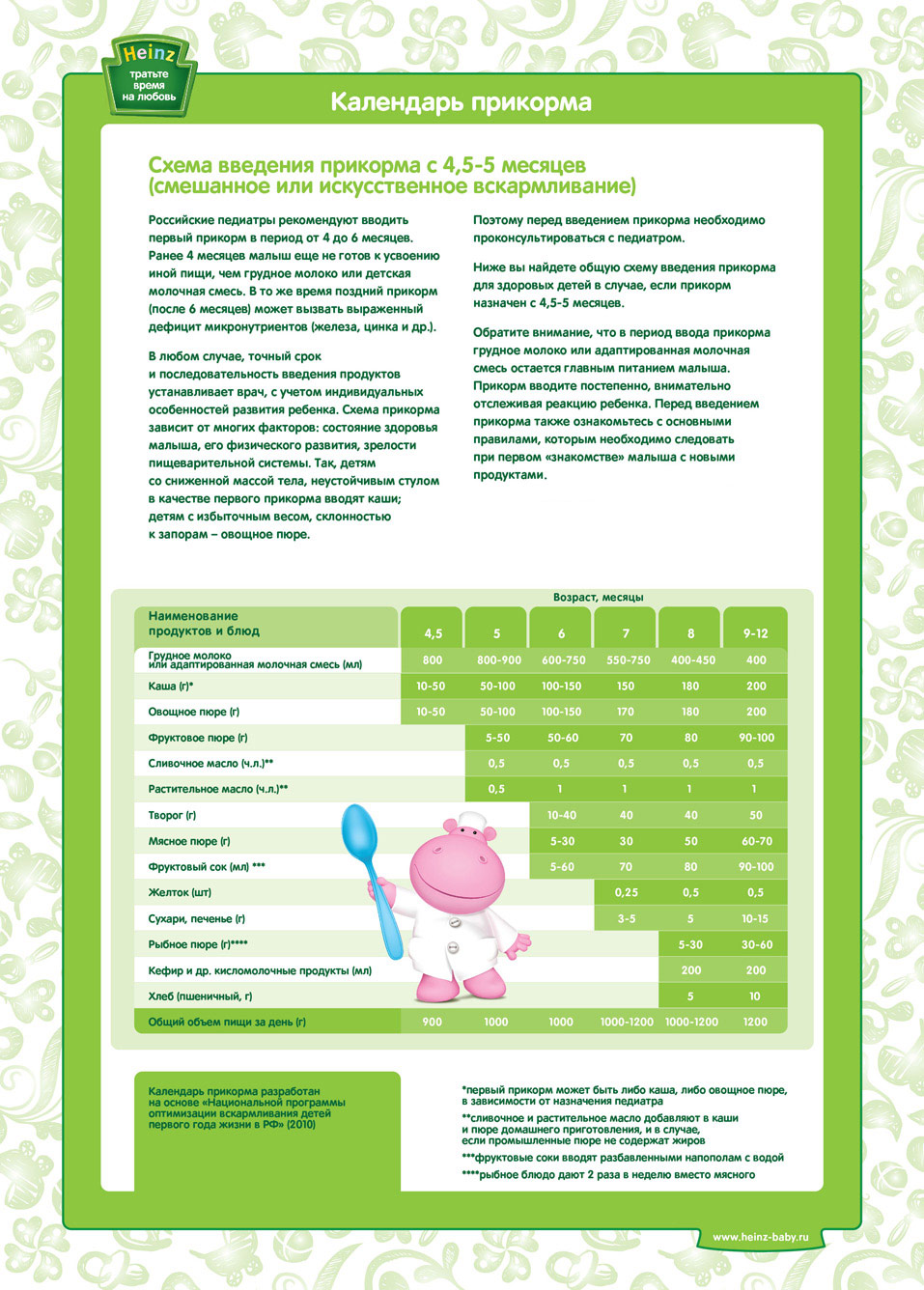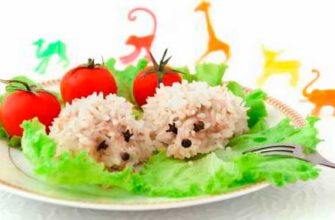According to WHO recommendations, at the age of 6 months, a healthy baby is as ready for feeding as possible. Although mother’s milk continues to be the main source of all substances important for life, the body is no longer enough energy, vitamins and trace elements. The baby’s digestive system is physiologically ready to digest coarser foods. Moreover, its use can cause the release of special enzymes that positively affect the motility of the gastrointestinal tract.
Age features - why from six months?
Many mothers mistakenly believe that if their milk is not enough to saturate the baby, then it is time to proceed to the introduction of complementary foods and from 2-3 months. Indeed, what could harm a couple teaspoons of applesauce or “such a healthy” carrot juice? In fact, this is fundamentally the wrong point of view. The baby’s digestive system is not able to digest anything except mother’s milk. If there is insufficient lactation, the pediatrician should pick up the child adapted milk formula. The introduction of early feeding is fraught with crumbs for such unpleasant consequences as:
- digestive upset;
- diathesis;
- food allergy (which may persist for many years);
- subsequent development of obesity.
On the other hand, late feeding is also harmful: it will lead to:
- lag in mental and physical development;
- risk of developing deficient conditions (ricketshypotrophy, anemia, hypovitaminosis);
- protein-calorie deficiency.
The body of the baby up to 5 - 6 months is not adapted to digest any food, with the exception of breast milk and adapted infant formulawhich are used in cases of insufficient lactation. But the age of 6 months is an average value. Accurate information about whether the infant is ready for the introduction of complementary foods can only be provided by a pediatrician observing its development. Children grow up not according to the exact scheme, each baby is individual: one is ready for feeding at 5 months, the other only at 9. The main factors that it is time for your son or daughter to start feeding are:
- The child is absolutely healthy:
- He shows an interest in food from the diet of adults around him;
- The baby's weight has doubled since birth;
- Breast milk is not enough for the baby: it is increasingly applied to the breast;
- The baby sits confidently without support;
- The ejection reflex (regurgitation) gradually fades away.
We also read: how to determine that the child is ready for feeding - 10 signs
Breastfeeding - where to start at 6 months
The main principles that must be followed when introducing complementary foods for the baby while breastfeeding:
- Feeding can be introduced only if the baby is completely healthy: there is no digestive system disorder (constipation, diarrhea), fever, there was and will not be a vaccine 5-7 days before and after the planned feeding;
- An additional dish must be given to the child when he is hungry, then breastfeed;
- The consistency of the dish should be as uniform and fluid as possible, the temperature should be moderately warm. It is especially useful to steam the vegetables and then grind them in a blender (or wipe through a strainer). With this cooking method, vitamins and nutrients are better preserved in vegetables;
- Feed the baby with a spoon and always in a sitting position;
- A new product can be given to a child only once a day. You should start with 0.25 - 0.5 teaspoon. Within two weeks, the portion should be increased to 150 g, which will replace one breastfeeding;
- New dishes are introduced gradually. The next product can be used in the diet after the body adapts to the previous one;
- Constantly monitor the condition of the child, his reaction to new products;
- Along with the introduction of complementary foods, accustom the baby to 5-tyrazovoy nutrition at intervals of 4 hours between feedings.
Products for the first menu
The choice of first meals for complementary foods depends on the characteristics of the body and the condition of the baby: if there is a problem of underweight, it is better to start with gluten-free cereals: corn, buckwheat or rice. If the child has a tendency to constipation, then with vegetable and fruit purees.
At the first stages, the dish should consist of one type of product: do not mix two types of vegetables, fruits or berries in one puree or juice.
The best products for the first vegetable feeding - cabbage of all varieties, the most useful of which are cauliflower and broccoli, potatoes and zucchini (especially if the baby has constipation). Then you can enter green peas. Colored fruits and vegetables (red apple, dark grapes, carrots, beets, pumpkins) are offered to the baby a little later.
No need to add sugar to fruit puree, and salt to vegetable puree. Half the yolk, vegetable oils (olive or sunflower) are added to the vegetable puree, starting from 1 drop and bringing to 1 tsp. for a full serving of mashed potatoes (150 g).
Since the child’s kidneys are not fully formed until the end of the year, in no case give the baby meat broths, which include a large number of purine bases. For soup, it is better to use vegetable broth.
The most useful way to cook vegetables is by steaming and chopping in a blender or through a strainer. With this heat treatment, a greater amount of vitamins and other beneficial substances is preserved. Mashed potatoes must be made liquid, the baby is not yet able to swallow thick foods.
Porridge for a 6-month-old baby (we begin to give one-component, gluten-free cereals. Such types include buckwheat, rice and corn porridge) are first cooked from one type of cereal. After three weeks, you can start mixing cereals. Preliminary it is recommended to grind them in a coffee grinder and only then cook. Both water and breast milk are suitable for cooking. It is useful to add melted butter to the finished porridge.

Tasting preferences of the child
Be very careful about the desires and taste preferences of the crumbs. If any dish is unpleasant for him and he turns away from the spoon, in no case do not insist. Give up on this product for a while. It can be re-offered after 3 or 4 weeks.
Do not force the child to force-eat the entire portion of complementary foods. In this case, the baby will suck less milk from the chest, which will lead to a decrease in its production and the extinction of lactation. It can also cause an aversion to a new dish and poor appetite in the future.
It is necessary to feed the baby with breast milk as long as possible. It remains the main food for up to a year, a source of growth hormones and antibodies that form the immunity of the child. Remember that the main task of complementary foods is not to translate onto a common table, but to form a natural eating behavior. Therefore, it is not so important whether the products and their quantity comply with the recommendations. It is necessary to take into account the desire for crumbs. If parents do not pursue the goal of observing a quantitative portion of baby food, then an active interest in food will remain, and breastfeeding will not be replaced. In this case, the transition to nutrition from a common table will be gradual.
We read in detail: breast-feeding
Recommendations for complementary feeding during artificial feeding
For babies who, for one reason or another, eat adapted artificial mixtures, they introduce lure a little earlier: from 4 to 5 months. This should be done on the preliminary recommendation of the supervising pediatrician and taking into account his advice. The introduction of complementary foods at such an early stage is due to the fact that for the full development of the growing body there are not enough nutrients obtained from mixtures.
The feeding regimen corresponds to the breastfeeding regimen for the infant. First, vegetable and fruit purees are also introduced into the diet. At 6 months, the artisans are already moving to the second stage of complementary feeding - milk (depending on milk tolerance) and dairy-free cereals with added butter, juices, cottage cheese, yolk, meat and fish purees diluted with water.
Artists may be obese, so do not abuse semolina. In addition to high nutritional value, it is essentially useless. With the frequent use of this cereal, the possibility of the appearance of conditions such as anemia or rickets is significantly increased.
When adding meat and fish dishes to the menu, you can use ready-made canned food (mashed meat) intended for children, but mashed or cooked in a blender at home will be more useful. The first meat purees are made from rabbit, turkey, veal or chicken meat. (when to give the child meat - the rules for introducing meat feeding)
We also read:IV feeding
(clickable)

A sample menu for a day for a 6-month-old baby, taking into account the introduction of complementary foods. 6-month-old baby feeding schedule
This regime is followed by European nutritionists and pediatricians:
For a naturally fed baby:
- 06:00 - Breast milk.
- 10:00 - Vegetable puree - 25-30 g. Breastfeeding.
- 14:00 - Porridge or mashed potatoes + supplement with mother's milk.
- 18:00 - Fruit puree - 25 - 30 g + breastfeeding.
- 22:00 - Breast milk.
For the child artificer:
- 06:00 - Adapted mixture (milk or sour milk).
- 10:00 - porridge in milk with butter and mashed vegetables or fruits
- 14:00 - soup (from vegetables), mashed vegetables with the addition of vegetable oil and half the yolk, freshly squeezed fruit juice
- 18:00 - milk mixture or cottage cheese, cookies
- 22:00 - kefir or adapted mixture.
The meal time may vary depending on the usual daily routine for the baby, but the interval of 4 hours between meals must be observed.
Summary
Contrary to the fact that mother’s milk is undeniably the best food for an infant up to a year old, complementary foods should be introduced into the diet as early as 6 months, and for artisans from 4–5. Before the set time, it is not necessary to feed the infant. It seems to many mothers that by doing this they will provide the body with a large amount of useful substances, although in fact the baby’s digestive system in hepatitis B is not ready for new foods for up to six months.
From 6 months, complementary foods are introduced gradually, without stopping breastfeeding. New products are given in small portions, thereby accustoming and adapting the child's gastrointestinal tract to the adult menu. From 6 months, the baby is transferred to 5-time feeding with a 4-hour interval.
When introducing crumbs to a common table, it is important to strictly follow the feeding regimen and the basic principles of introducing complementary foods. Reasonable recommendations, taking into account the particular development and health of a particular child, can be given by a doctor who observes the baby.
We also read: When and where to start the first lure, how to introduce new products: the basics, tips and rules
Our history of complementary foods (6 months)
How to feed a baby at the age of 6 months. Tips for parents - Union of Pediatricians of Russia










In the article, they also forgot to say that complementary foods can be administered to babies who have already acquired teeth. We began to try “adult” food from 8 months. I began to give a little fermented milk product, which I myself cook using Bifidum sourdough from Bakzdrav. The product is probiotic, which is good for children who have digestive problems. The bacteria that are contained in its composition help maintain the balance of microflora, which means that the further introduction of new products will be easier.
We have been on IV since birth, so we had complementary foods earlier, about 4.5 months later I started giving juice 2-5 spoons after the mixture. Vegetable purees, but the child didn’t eat meat, I’m joking))))) We live in Moscow, my husband and I have relatives in the village and our farm, we took chickens, rabbits from them, our hens, rabbits without any chemistry, now eats a little (6 months), but the fact that the banks do not. She loves rabbits very much. And at night, the milk mixture, of course, I don’t give either kefir or milk, I’ll only introduce it from the year on, or maybe replace it with a milk drink. But we were lucky, we picked up a good milk mixture, it has both pro- and prebiotics, so there was somehow no problem with digestion. There were colic, but for a very short time the first three weeks and not because of the mixture)) We are on Materna (we take it in baby1care). And the vitamin composition is good. Everything is fine with sleep now)